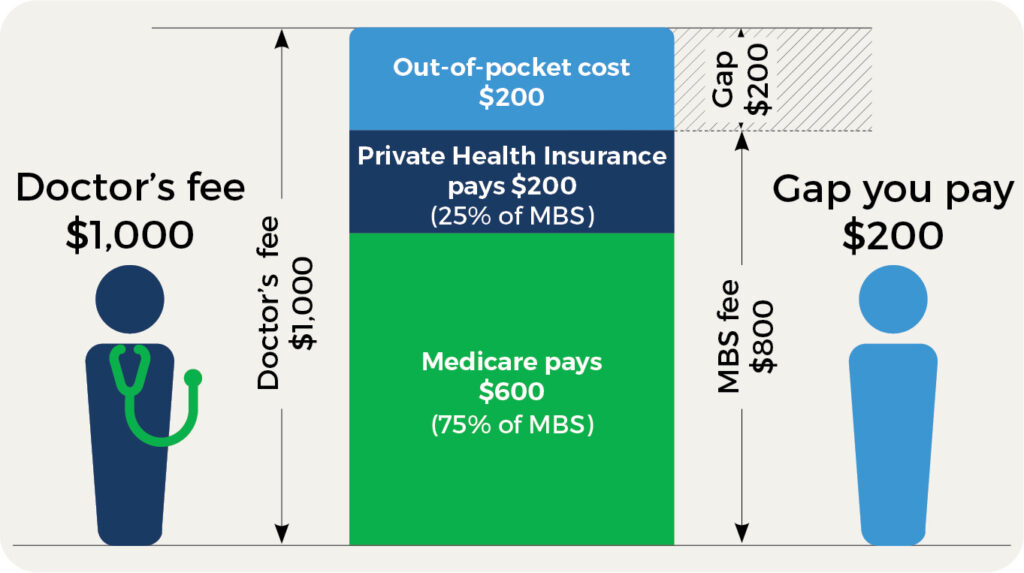 Allianz Care Australia
Allianz Care Australia
 CBHS International Health
CBHS International Health
So, you’re having a hospital procedure as a private patient, and you’re covered by private health insurance. That means your treatment is free, right? Unfortunately that’s probably not true. There are 4 types of costs you might face for Hospital Cover claims. Here’s what they are, and how to prepare for them:

1. Excess
Most Hospital Cover policies have an excess, which is the amount you have to pay towards a claim before your insurer kicks in. The excess for Hospital Cover is generally between $100 and $750, depending on your policy, although some insurers allow you to increase the excess even higher to reduce your premiums.
When you’re treated as a private patient, you’ll usually have to pay the excess directly to the hospital, but check with your insurer about their excess payment process. Generally, you’ll only have to pay an excess once per year (which is handy if you have more than one private hospital visit in a year). But if your policy is for more than one person (e.g. it includes your partner and/or kids) you’ll have to pay the excess again if another person on the policy is hospitalised in the same calendar year. The good news is that many Single Parent and Family policies don’t have an excess for a child hospitalisation.
If you choose to be treated in a public hospital as a private patient, you may still have an excess to pay. Check with your insurer.
2. Co-payment
Commonly confused with an excess, a co-payment (sometimes called a ‘daily charge’ or ‘per-day charge’) is the amount you might pay for each day of a hospital stay (including day surgeries). Co-payments are up to a set limit per year, with your insurer paying the rest. Insurers offer co-payments on some Hospital Cover policies in exchange for a lower premium. Essentially, it means you’re agreeing to help your insurer with part of your treatment costs.
Co-payments apply to treatment in a private hospital, and in a public hospital if you’re treated as a private patient.
If you’ve got a policy with co-payments and you’re being admitted to hospital as a private patient, ask your insurer about the payment process.
3. Gap or out-of-pocket cost
What’s the difference between a Gap and an out-of-pocket cost? Absolutely nothing. These 2 terms are used interchangeably, but they mean exactly the same thing. Now that we’ve cleared that up, here’s what a Gap means for your pocket.
A Gap is the difference between what your doctors charge for treatment and what your health insurer and Medicare combined will pay. Gaps happen because Medicare can only pay up to 75% of the MBS Fee (Medicare Benefit Schedule Fee) that the government sets for treatment, while private health insurers pay the remaining 25%. So if your doctor charges more than the MBS Fee – which many do – you’ll have to pay the difference as a Gap or out-of-pocket cost.
However, if your doctor has a gap arrangement with the insurer, the insurer might agree to pay more than the usual portion of the MBS, which could mean no Gap or a smaller Gap (usually called a ‘known Gap’) for you.

For Hospital Cover claims, there are 2 types of Gaps:
- Medical Gap – for doctors’ fees, including surgeons, anaesthetists, radiographers and pathologists.
- Hospital Gap – for hospital fees such as theatre costs, food and accommodation. If you have your procedure at an Agreement Hospital, this generally won’t apply. Hospital Gaps also shouldn’t apply to private patient treatment in a public hospital, but always check with your insurer to make sure.
How do I lower my out-of-pocket costs?
4. Out-of-hospital costs
Costs related to your hospital treatment could include:
- Outpatient appointments before and after hospitalisation. For example, visiting your orthopaedic surgeon in their clinic to assess your health concern, and discuss the procedure. By law, Hospital Cover cannot cover anything outside of hospital, so you’ll have to pay the Gap between what Medicare covers and what the doctor charges.
- Rehabilitation and recovery treatments outside hospital. For example, physiotherapy outside hospital following a knee replacement is covered by Extras Cover, not Hospital Cover. Most policies will not cover the full amount charged by your healthcare professional, which means out-of-pocket costs for you.
Do I have to pay out-of-pocket fees for treatments outside of hospital?
Note: If your rehabilitation treatments happen in hospital, you can claim this on Hospital Cover. However Basic, Bronze and Silver tier policies might have restricted cover for the Rehabilitation clinical category, which would mean a Gap for you to pay.
What is ‘informed financial consent’?
According to the Commonwealth Ombudsman, informed financial consent means knowing your treatment costs upfront. It’s important to ask for a breakdown of costs from your doctors, including all surgeons and anaesthetists, before you agree to any hospital treatment. Make sure you ask your doctors and health insurer about any out-of-pocket costs, and get the information in writing, to make sure you’re not hit with bill shock.
How to find a policy with lower hospital costs
Want to find a health insurance policy with a lower excess or no co-payments? Search the healthslips.com.au Calculator to find the best policy that meets your needs, knowing that we’ll leave no stone unturned to give you all your options. We compare every policy in the market without bias, and you don’t have to sign up to get your results. The healthslips.com.au Calculator makes finding and comparing health insurance a cinch – try it now. Look for a new policy or compare your existing policy with others in Australia. You’ve got nothing to lose, and potentially some money to save.

Knowledge is power – that’s the guiding principle behind everything Trudie writes, and it’s a philosophy she brings to her work at healthslips.com.au. By breaking down complex information into easy-to-understand blogs and stories, she aims to empower Australians to make the best choices and an informed decision around private health insurance.
Trudie understands firsthand some of the complexity of private health insurance having moved to Australia from New Zealand and having to navigate a vastly different public healthcare system and health insurance structure.
Trudie holds a Bachelor of Communication Studies (journalism major) from the Auckland University of Technology.
Policies change monthly, stay informed
- Insurers regularly update policies, introduce new policies and close policies. Our data is updated monthly.
- We will only send information relevant to you. You can unsubscribe at any time. See our Privacy Policy.





